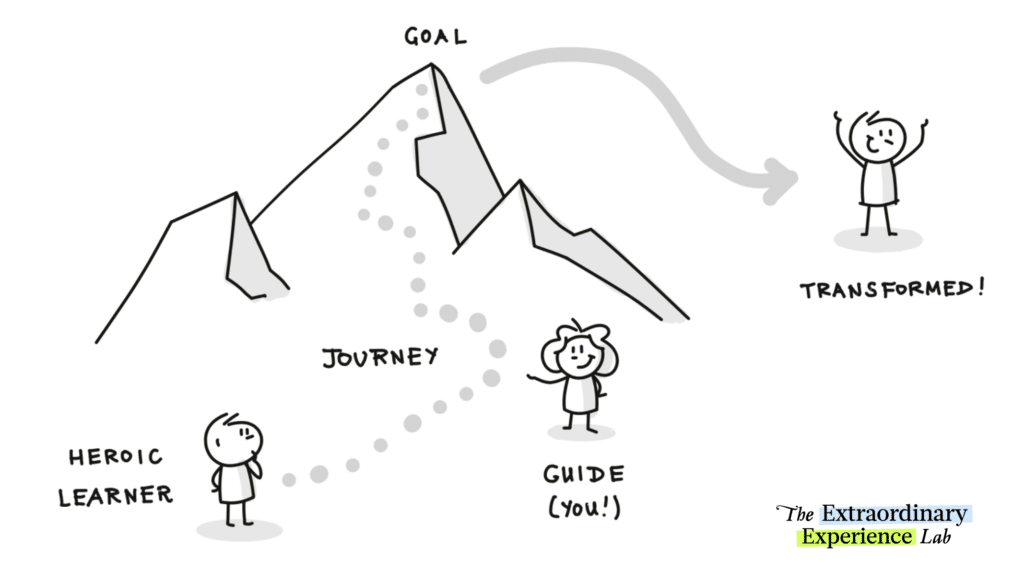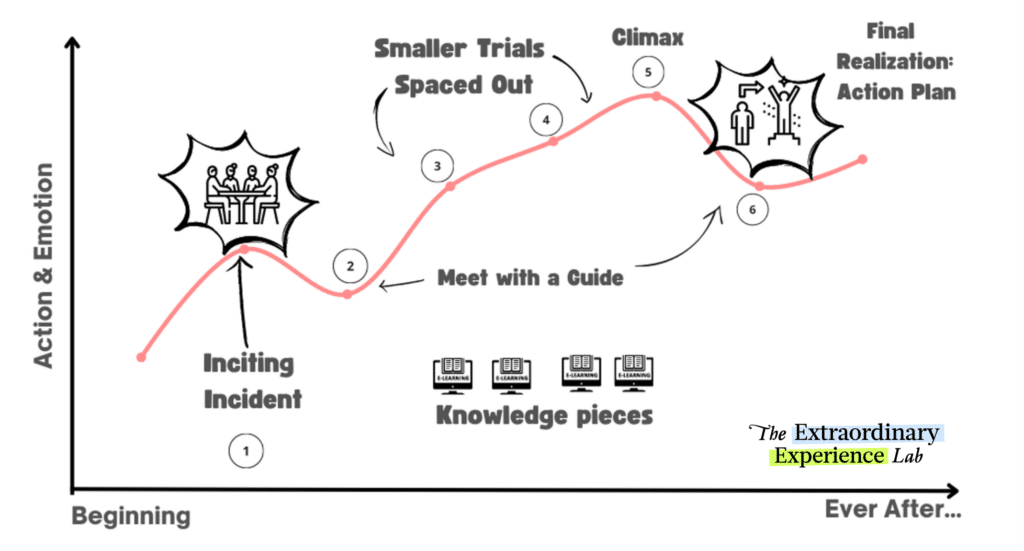Our team has recently become obsessed with the connection between stories and learning.
But we’re not talking about storytelling. We’re interested in story design.
In the following, we introduce the idea of story as a powerful metaphor for a learning journey, along with four ways in which you can bring Story-Driven Learning Design to your work today.
Thanks for being here!
A well-crafted story is a powerful metaphor for a learning journey
Have you ever gotten completely lost in a great story? Maybe it was a thrilling movie, a gripping book, or a captivating Netflix series. (Disney anyone? Marvel? Black Panther? Star Wars? Breaking Bad? Harry Potter? Something else?!)
It doesn’t matter what it is, what’s important is the experience it provided you and what all such stories have in common: : a storyline that pulls you along. So you can’t stop watching or reading
Take a moment to think back on the plot of your favourite story:
Does it begin with a hero who has untapped potential? (Most likely.)
There is probably also some kind of catalyst or call to adventure that alters their world and propels them into a series of challenges they must rise to meet.
Does the hero face some trials? (Oh yes.) And usually there will be a few false victories, but, in the darkest moment, they fail.
(Cue dramatic music.)
That’s when they have to dig deep to muster all their forces and confront the one true thing they need to accept or learn about themselves in order to take action, change or truly transform and be victorious.
Doesn’t that sound a lot like a significant learning experience?
Almost every great story has these same elements. And what’s really interesting is that those elements are not all that different from a personal development journey.
Think about it:
Just like your favourite hero, a learner also has untapped potential.
They have dreams and aspirations that they may not even be aware of yet. But just like a hero in a book or movie, there will come a time when a catalyst forces them out of their comfort zone and into a series of challenges. There will be other characters and a guide (you!) who accompanies them on their journey and helps them uncover their goals and motivations, and overcome their problems.
Those problems may seem insurmountable at first. The learner may face setbacks and false victories, but ultimately, they’ll experience moments that force them to confront the things they need to learn in order to take action, change, or transform.
Just like a hero in your favourite book or movie, a truly transformative learning journey will change the learner in ways they never thought possible. It will force them to grow, to learn, and to become the best version of themselves.
Isn’t this what every truly transformative learning experience should be like?
We think so. Our hypothesis is that you can apply a story structure to the design and structure of your learning experience for more engaging, dynamic and transformative learning experiences.
To begin to uncover how this all could work, we recently invited folks into two labs to introduce ideas and frameworks for Story-driven Learning Design and something we call The Heroic Learner Profile. Below is a breakdown of the main ideas.
Four ways to bring Story-Driven Learning Design into your solutions
1. Find the storyline in your experience
Can you visualize the story journey in your course or program?
It might be time for a mindset shift.
Instead of viewing your program as a flat document or a series of curriculum events in a chart, try thinking in terms of the storyline that your learner is embarking on. What’s their backstory coming into your course or seminar? What are you inviting them into? What’s the journey ahead of them?

By shifting your perspective in this way, we propose that you’ll be able to craft a more engaging and transformative learning experience. Instead of just presenting information, you can take your learners on a journey, inviting them to become the heroes of their own stories.
This might sound like overkill if you’re only teaching a module or two on statistics or a topic on workplace health and safety, we know. But what if it’s not? What if this kind of mindset shift can make all the difference even in such cases.
So, take some time to think about the storyline of your program. What are the key moments that will shape your learner’s journey? What challenges will they need to overcome? What lessons will they learn along the way?
With this approach, you’ll be able to create a more compelling and impactful learning experience that truly resonates with your learners.
2. Let the learner be the hero! (Not you, sorry.)
We know you’re the expert, but in a truly story-driven design, your role is to be the guide on the side. Welcome to your Dumbledore years, where you’ll be supporting and guiding learners as they embark on their own hero’s journey.
Instead of planning the curriculum around what you want to say or deliver, start by envisioning your learner as the protagonist in their own development story. What experiences do they need to level up? What challenges and milestones will they need to overcome and end up transformed?
By giving your learners what we call their main character moment, you can create a more engaging and effective learning experience. And by embracing your role as the guide on the side, you’ll empower learners to take ownership of their learning journey and become the heroes of their own story.
So, take a step back and let your learners take the lead. With you as their guide, they’ll be able to navigate challenges, overcome obstacles, and ultimately emerge transformed. After all, in the words of Dumbledore himself, “It is our choices, Harry, that show what we truly are, far more than our abilities.”
3. Explore story structures to add drama and energy to your course experience
Beyond just using Learning Experience Design (LXD) and other curriculum design structures, consider taking inspiration from proven story structures used in screenwriting and novel writing to create a more powerful learning journey.
Have you ever looked at Aristotle’s Three-Act Structure, the Nine-Act Screenwriting Structure, or the classic Hero’s Journey?
Think about how you can borrow elements from these and other structures to create a more engaging and transformative learning experience. Do you have an inciting incident that grabs your learner’s attention and sets the stage for their journey? What meaningful tests and trials can you incorporate to challenge your learners and help them grow? And what about a climax that brings everything together and leaves your learners feeling inspired and transformed?
By incorporating these story elements, you’ll be able to add some energy and emotion to your design, making it more memorable, impactful, and relevant for your learners.
4. Design the narrative arc for your learners
If a story simply goes from point A to B without any rising or falling action, it’s usually pretty boring – and there’s no real change that happens to the main character. Well, the same goes for your learning experience.
When designing your course, think about the growth curve that your learners will go through. Where are the moments of high action or intense emotion? What are the peak moments and pitfalls that your learners will encounter along the way?

These moments are usually where your learners will face a challenge, and that’s what truly brings about personal learning and change. So, if your learner’s journey is a flat line, it’s time to consider how to engineer a change or transformation opportunity. How can you create moments that challenge your learners and encourage them to grow?
By designing a narrative arc that includes these moments of challenge and transformation, you’ll be able to create a more engaging and impactful learning experience for your learners.
So, how do you get started?
Story-driven learning design is a lens through which you can begin to see and communicate a clear storyline and narrative growth arc for your course or learning experience. The first step, is simple, just start thinking about: who’s my learner and what’s their story? Then consider how you can begin to visualize their learning experience a little differently and use story structure to engineer some energetic elements in your course or experience.
Don’t be afraid to think like a storyteller and craft a narrative that will help your learners truly grow and change.
Until next time!
Best,
Kristi, Alex, and Matt
Video introduction
The following teaser introduces the Heroic Learner Profile in the context of our thinking on Story-Driven Learning Design:
Attribution
Please attribute this post as follows:
“(How) Can Story be Used to Design a Learning Experience?” Extraordinary Experience Lab blog post, https://extraordinaryexperiencelab.org/url. Published Feb 28, 2023. Accessed Month Day, Year.
For more on story: Work that inspires us
Here are a few examples of what we’ve been reading on story and on the use of story as a tool for design:
Story Proof: The Science Behind the Startling Power of Story by Kendall Haven
Building a StoryBrand: Clarify Your Message So Customers Will Listen by Donald Millar
Resonate: Present Visual Stories that Transform Audiences by Nancy Duarte
GMC: Goal, Motivation, and Conflict by Debra Dixon
Story Design: The Creative Way to Innovate by Denise Withers
In our labs and workshops, we eagerly share what we’re reading and researching and works that have inspired our thinking from the world of story, writing, design and learning experience. Please join our community, to exchange ideas and sources with other designers creating extraordinary experiences across the globe.
Thank you!
At the Extraordinary Experience Lab, we’ve maintained a commitment to building ‘in public’ a series of accessible tools and frameworks for creating extraordinary experiences. Our labs are open to invite dialogue and diverse perspectives. We’d like to thank our community members for their comments and feedback that help shape and evolve these tools and ideas. If you have comments or thoughts to share, please join us. We’d love to hear from you.
Sincere thanks to three extraordinary leaders in the field of LXD, Josh Cardoz, Bianca Baumann, and Theodore Paris for their thoughtful input on early versions of our Story-driven Learning Design labs.
